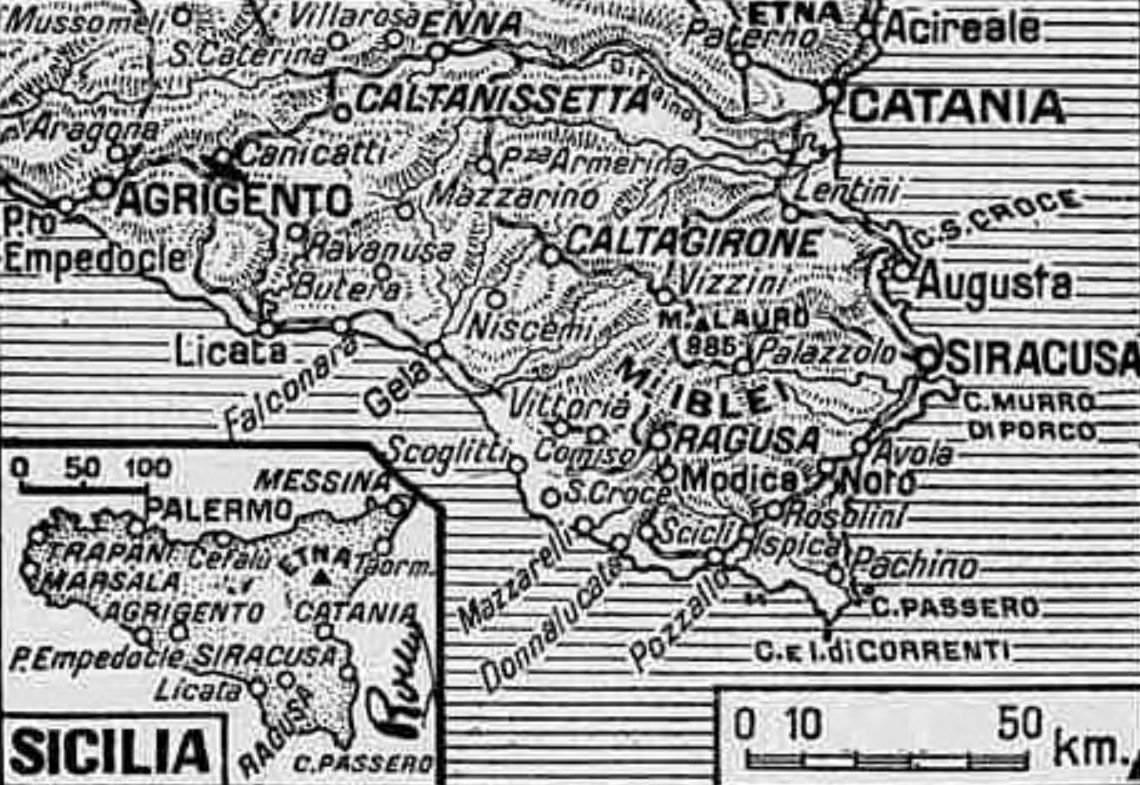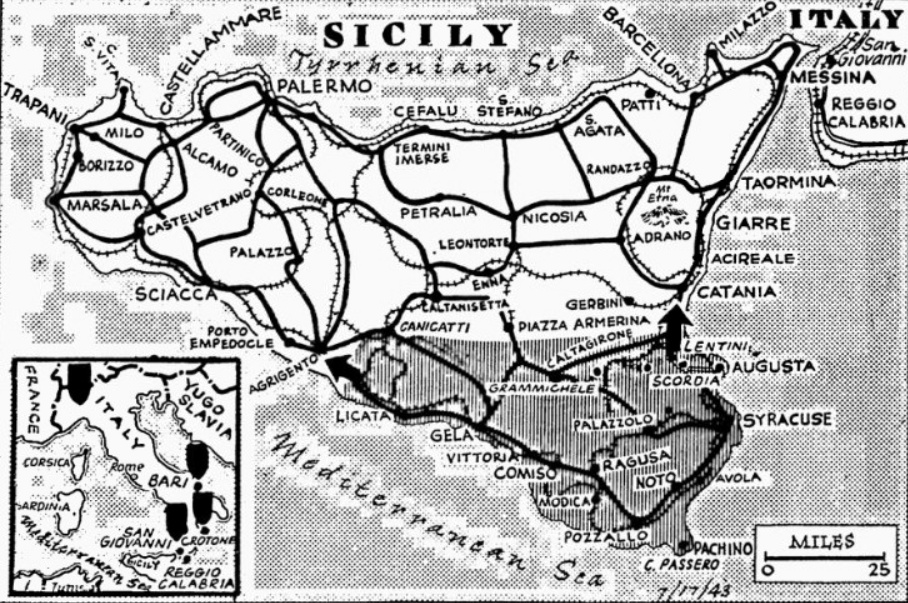The Pittsburgh Press (July 15, 1943)
AXIS DRIVE IN SICILY REPULSED
Messina almost destroyed by bombs; Americans take 6th airfield
Allied forces advance steadily in Sicily after repulsing a strong Axis counterattack on Augusta. About one-eighth of the island, shown by the shaded section of the map, is already occupied. The planes show location of five of the six airdromes captured by U.S. forces. Messina was almost completely wrecked by Allied bombers.
Yanks drive on Agrigento
By Virgil Pinkley, United Press staff writer
Allied HQ, North Africa –
Allied forces fought off a powerful Axis counterattack led by crack German units in the Augusta sector of Sicily and struck back today in increasingly heavy battles toward Catania on the east coast and Agrigento on the south coast.
U.S. forces on the south coast captured another Axis airdrome, the sixth seized by the Yanks since the start of the invasion five days ago. They also took several important hills, a communiqué announced.
U.S. troops in Sicily have pushed 10 miles north of Ragusa in heavy fighting and captured “the seventh airfield” to fall into Allied hands, the CBS reported today from Allied headquarters in North Africa.
What appeared to be the first major enemy counterblow was struck by strong forces in a drive that penetrated British lines to the Augusta Harbor before being repelled.
For several hours after dawn yesterday, while heavy fighting raged on the Augusta sector, the British were cut off, but they rallied and restored the situation and hammered their way back beyond the town of Brucello, about four miles north of Augusta on the road to Catania, where Allied warships and airplanes continued to pound the enemy rear.
The Axis used heavy tanks in their counterattack and a number were destroyed. Canadian tanks participated in the battle.
U.S. and British parachute and airborne troops carried out successful operations, but Axis resistance was stiffening on most sectors and was especially strong on the edge of the Catania Plain north of Augusta. A major battle for Catania was expected.
The NBC correspondent on a British cruiser off Sicily said that the British had captured Lentini and Carlentini, which close together about 10 miles west of Augusta, and had isolated an Axis division there. The capture was made by paratroopers and Commandos who landed in the enemy rear.
The Axis said that two Allied paratroop operations had been launched in this sector.
Axis artillery was in action against the British north of Augusta, but Italian prisoners said that the enemy was suffering heavy casualties, including many due to moving back through their own minefields.
NBC reported that a British cruiser squadron heavily shelled Catania late yesterday for 35 minutes and broke up enemy efforts to move a big gun train south of Catania.
The British occupied Melilli, which had been bypassed near Augusta.
Observers in London placed the British 8th Army only about 15 miles south of Catania.
The commanding general of the famed Italian Napoli 54th Division and his entire staff were captured by the British.
Yanks advance four miles
U.S. forces on the south coast extended the western flank of the Allied invasion front about four miles in hard fighting. The Americans were now near Agrigento and menaced the main Axis communication lines to the western
The western advance appeared to be a within few miles of Agrigento.
Agrigento is a communications center of 26,000, founded before Christ. Port Empedocle, which is nearby, had been shelled by U.S. warships. The Americans captured several dominating hills on the approaches to Agrigento.
The Sicilian population was reported friendly in most occupied areas, often waving, cheering and giving the V-for-Victory sign to the Allied troops.
In many instances, the Italians surrendered without a serious fight, but German troops fought hard and were disconsolate when captured. Many prisoners were being moved quickly to North Africa because of the food shortage in Sicily, where the Allies have been feeding the population as rapidly as possible.
12,000 prisoners captured
At least 12,000 prisoners have been captured, 8,000 of them by the Americans, the communiqué said, and Allied control of the Mediterranean is so secure that 8,000 of them have already been transferred to Africa.
The airdromes captured by the Americans were those at Comiso, Pachino, Biscari, Licata and two in the Gela area. In addition, the British captured the seaplane base at Syracuse.
Field dispatches indicated that the Allied forces were advancing toward the great central plains of Sicily on a 75-mile point.
Some forces may have already entered the flatlands, especially below the big east coast port of Catania, which was under relentless sea and air bombardment.
Eighth of Sicily seized
More than one-eighth of Sicily was now in Allied hands.
The Germans and Italians were still pushing reinforcements by sea despite heavy raids by Allied bombers and torpedo planes, dispatches said.
Allied planes, along with a British “mosquito fleet” of motor torpedo boats, were peppering the Strait of Messina, shortest route of reinforcement, without respite. Some torpedo boats have penetrated the straits to a point where it is only three miles to hunt out enemy torpedo boats that might harass Allied landings farther south.
An Algiers broadcast recorded by the Exchange Telegraph Agency in London said that Anglo-American-Canadian troops had breached Catania’s defenses and a Madrid report asserted that Allied spearheads had reached the outskirts of the city.
Another Algiers broadcast reported that U.S. troops had advanced nearly 19 miles north from Comiso, airport town seven miles west of Ragusa.
Catania
The approach of the 8th Army under Gen. Sir Bernard L. Montgomery to Catania was indicated by an RAF announcement that the city, second largest in Sicily, was under aerial and naval bombardment “immediately ahead” of British ground forces.
U.S. troops under Lt. Gen. George S. Patton Jr. were pushing a four-pronged advance into the interior and westward along the south coast, the coastal force was believed 13 miles beyond Licata and only 12 miles from Agrigento and Porto Empedocle, where large enemy concentrations have been reported.
North of Licata, another U.S. force was only 15 miles from Caltanissetta, a large enemy base in the central plains.
2 columns drive north
Two other columns were driving north from Gela, some 20 miles east of Licata. One was only 10 miles from Caltagirone, a gateway town to the central plains.
Gen. Sir Harold R. L. G. Alexander, commander of Allied ground forces, in an interview with Mr. Gunther on his return from a visit to Sicily indicated that the invasion was going to schedule and up to program.
Gen. Alexander seemed particularly delighted at the way U.S. and Canadian forces conducted themselves, Mr. Gunther said.
Big air fleet blasts harbor
By Reynolds Packard, United Press staff writer
Allied HQ, North Africa –
Allied air fleets, including 270 bombers from the Northwest African and Middle East Commands, struck pulverizing blows at Messina yesterday, all but completing the destruction of the key Sicilian port, communiqués revealed today.
Two hundred bombers of Lt. Gen. Carl A. Spaatz’s force were joined in the assault on Messina by 70 Liberators from the Middle East. The Liberators dropped more than 400,000 pounds of explosives on the gateway to and from Italy.
The massive raids on Messina, across a two-mile strait from the Italian mainland, topped another 24 hours of non-stop attacks by Allied bombers and fighters blasting out a path of destruction across Sicily in advance of Allied troops smashing northward and westward.
An Italian communiqué reported that Allied planes raided Naples, one of the main reinforcement ports for Sicily, and the Sicilian northwest coast port of Palermo in addition to Messina last night.
Sever route
The around-the-clock attacks on Messina, plus other raids on the mainland ferry terminals of San Giovanni and Reggio Calabria, opposite Messina, and British torpedo boat attacks on channel shipping, were believed virtually to have severed that route of reinforcement and supply for Sicily.
The Allied air forces were also ranging over waters north of Sicily to stem reinforcement from that source. British Beaufighters yesterday torpedoed and blew up a tanker, set fire to a small tanker and probably sank a freighter, bosting the number of enemy vessels sunk in that area in the past three days to 14.
The Allied control of the air is so complete that U.S. and British fighters are operating from newly-captured airdromes in Sicily. Only a few enemy fighters were encountered yesterday, and of these, three were shot down. Three Allied planes were lost.
Set large fires
The 200-plane Northwest African Air Force that hit Messina in relays was spearheaded by Flying Fortresses and also included Mitchells, Marauders and Canadian Wellingtons and P-38 Lightnings running interference.
Large fires sprang up in the wake of the raiders and heavy damage was inflicted on railway yards, ferry ships and oil storage areas, where two heavy explosions occurred. A smoke pall covered the city as the last of the raiders left for the base.
Sandwiched between the Northwest African Command raids was the one by the Liberators of the U.S. 9th Air Force in the Middle East on railway yards. Many direct hits and explosions were observed.
Raid San Giovanni
Another formation of Liberators bombed San Giovanni, on the toe if the Italian boot opposite Messina, scoring hits on oil tanks, customs warehouses, the ferry terminals, a fire station, railway tracks and engine sheds. Two explosions were also observed among harbor installations.
Still another attack on Messina was made Tuesday night by Northwest African night bombers.
Day-and-night raids were made on Enna in central Sicily, where enemy troops have been reported massing for major counterattacks.
South African Baltimores and Bostons teamed with U.S. medium and light bombers in attacking road and military targets. troop concentrations and transport columns in the enemy rear Tuesday night. Some Baltimores attacked Axis positions as the U.S. 7th Army illuminated the entire countryside with flares and incendiaries.
Attack merchant ship
A communiqué said:
Our fighters, operating from North Africa, Pantelleria, Malta and Sicily, maintained their patrols over Allied shipping, the beaches and the battle area and show down three of the small number of enemy aircraft encountered.
A Ju 52 was shot down during attacks on shipping north of Sicily.
British Wellingtons from the Middle East Command attacked a merchant vessel in the Lefkas Channel off the west coast of Greece, but results were not observed.
One plane was lost from all Middle East Command operations.
Escort bombers
Lightning fighters escorting the bombers on the Messina raids encountered only a few Axis fighters, indicating that the pounding of airdromes in Sicily and southern Italy was bearing fruit.
Mitchell medium bombers escorted by Lightnings scored direct bomb hits on both ends of a railway tunnel in the region of Enna, and were believed to have sealed it against use for some time.
Patrols ranged Sicily all day, shooting up trains and trucks. Three locomotives were destroyed, along with 30 railroad cars and dozens of trucks.


